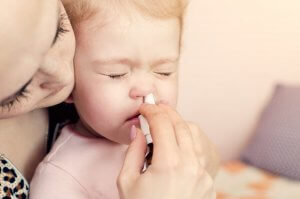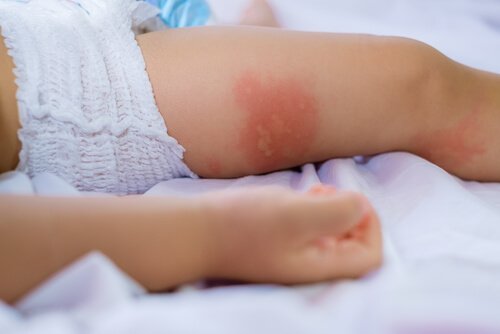Children's Allergy Tests: What Do They Consist of?


Reviewed and approved by the doctor Nelton Ramos
Children’s allergy tests consist of a series of examinations that include skin studies, food intake, and blood analysis. These allow doctors to know if there are substances that can awaken hypersensitivity in children’s bodies.
There is currently an increase in allergic diseases in children. It’s motivated, in part, by increases in sanitation and hygienic lifestyles. This has led our system to direct its attention towards immune responses and not towards the fight against infectious diseases.
Undoubtedly, it has become imperative to perform children’s allergy tests from an early age. For that reason, here’s what you need to know to identify possible allergies in your children by the hand of a professional.
Children’s allergy tests: what do they consist of?
There are many substances that can generate allergic reactions in children. They can be food, medicine, contact with animals or insects such as acari – commonly known as mites – and flowers.
The reasons why the body responds negatively and is susceptible to these substances also differ from one person to another. However, it’s estimated that many of the allergies are directly related to individuals’ genetic characteristics.
Nowadays, specialists recommend that parents have their children undergo allergy tests. This is due to an increase in visits to the doctor by children who experience outbreaks.
Moreover, parents tend to confuse food intolerances with food allergies. They aren’t the same: in the former, the metabolic system is the one affected; in allergies, the problem occurs in the immune system.
To avoid this or to ensure that parents begin to discard food, substances, and drugs at random, we recommend settling all doubts by seeking expert and qualified help.

Types of tests to rule out allergies
The most important consideration to take into account, which is one of the most common questions parents have, is how old children have to be to get allergy tests. It’s also important to know if these examinations are going to cause them any pain or illness.
The answer is that food and drug allergy tests should be done as soon as possible. Otherwise, a diagnosis can be overdue, which is usually present in the children since the first days of their birth.
Respiratory allergies due to flowers or contact with animals can appear when a child is about one or two years old. They appear after prolonged exposure. Regarding pain, the tests aren’t invasive and the discomforts are small and temporary.
Puncture test
It’s also called a prick test. It consists of subcutaneously applying samples of the allergen element and observing how the skin responds after 20 minutes pass. This test is the most recurrent because it’s quick and painless, with very low error margins.
Variations of this test are the prick-to-prick test, in which the concentrations and natural state of the allergen vary. Intradermoreaction is a test in which the substances are injected into deeper layers of the skin.
Patch test
It entails adhering a patch for 48 hours with the substance that you want to study as an allergen agent. After that, the reactions on the child’s skin are studied.
“Food and medication allergy tests should be carried out as soon as possible.”
Blood tests
Generally, blood tests are performed if it hasn’t been possible to reach conclusive diagnoses after the skin tests. Consequently, they’ll measure the levels of allergic antibodies in the child’s blood.

Provoking tests
It consists of administering the substance that produces allergy to the child through four different types of pathways: bronchial, nasal, oral, and conjunctival.
Specialists must apply all these tests; allergists usually practice it. Obviously, they should never be done as an experiment at home. In addition to not having the measuring instruments to reach successful conclusions, it can cause harm to the child’s health.
Lastly, remember that you should always consult your doctor if you have any questions about children’s allergy tests.
After an oral evaluation of the conditions and the recurrences of the child’s allergies, the doctor will tell you which type of exam is the most appropriate for your child.
Children’s allergy tests consist of a series of examinations that include skin studies, food intake, and blood analysis. These allow doctors to know if there are substances that can awaken hypersensitivity in children’s bodies.
There is currently an increase in allergic diseases in children. It’s motivated, in part, by increases in sanitation and hygienic lifestyles. This has led our system to direct its attention towards immune responses and not towards the fight against infectious diseases.
Undoubtedly, it has become imperative to perform children’s allergy tests from an early age. For that reason, here’s what you need to know to identify possible allergies in your children by the hand of a professional.
Children’s allergy tests: what do they consist of?
There are many substances that can generate allergic reactions in children. They can be food, medicine, contact with animals or insects such as acari – commonly known as mites – and flowers.
The reasons why the body responds negatively and is susceptible to these substances also differ from one person to another. However, it’s estimated that many of the allergies are directly related to individuals’ genetic characteristics.
Nowadays, specialists recommend that parents have their children undergo allergy tests. This is due to an increase in visits to the doctor by children who experience outbreaks.
Moreover, parents tend to confuse food intolerances with food allergies. They aren’t the same: in the former, the metabolic system is the one affected; in allergies, the problem occurs in the immune system.
To avoid this or to ensure that parents begin to discard food, substances, and drugs at random, we recommend settling all doubts by seeking expert and qualified help.

Types of tests to rule out allergies
The most important consideration to take into account, which is one of the most common questions parents have, is how old children have to be to get allergy tests. It’s also important to know if these examinations are going to cause them any pain or illness.
The answer is that food and drug allergy tests should be done as soon as possible. Otherwise, a diagnosis can be overdue, which is usually present in the children since the first days of their birth.
Respiratory allergies due to flowers or contact with animals can appear when a child is about one or two years old. They appear after prolonged exposure. Regarding pain, the tests aren’t invasive and the discomforts are small and temporary.
Puncture test
It’s also called a prick test. It consists of subcutaneously applying samples of the allergen element and observing how the skin responds after 20 minutes pass. This test is the most recurrent because it’s quick and painless, with very low error margins.
Variations of this test are the prick-to-prick test, in which the concentrations and natural state of the allergen vary. Intradermoreaction is a test in which the substances are injected into deeper layers of the skin.
Patch test
It entails adhering a patch for 48 hours with the substance that you want to study as an allergen agent. After that, the reactions on the child’s skin are studied.
“Food and medication allergy tests should be carried out as soon as possible.”
Blood tests
Generally, blood tests are performed if it hasn’t been possible to reach conclusive diagnoses after the skin tests. Consequently, they’ll measure the levels of allergic antibodies in the child’s blood.

Provoking tests
It consists of administering the substance that produces allergy to the child through four different types of pathways: bronchial, nasal, oral, and conjunctival.
Specialists must apply all these tests; allergists usually practice it. Obviously, they should never be done as an experiment at home. In addition to not having the measuring instruments to reach successful conclusions, it can cause harm to the child’s health.
Lastly, remember that you should always consult your doctor if you have any questions about children’s allergy tests.
After an oral evaluation of the conditions and the recurrences of the child’s allergies, the doctor will tell you which type of exam is the most appropriate for your child.
All cited sources were thoroughly reviewed by our team to ensure their quality, reliability, currency, and validity. The bibliography of this article was considered reliable and of academic or scientific accuracy.
- Smart, J; Robinson, M. Allergy testing and referral in children. Australian Family Physician Vol. 37, No. 4, April 2008. [En línea] Disponible en: https://www.racgp.org.au/afpbackissues/2008/200804/200804robinson.pdf
- Sheldon, J; Miller, L. Allergy Diagnosis reference guide. Clinical Biochemistry. BIO NO 116. 2014. [Online] Avaiable at: https://www.mtw.nhs.uk/wp-content/uploads/2015/08/Allergy_diagnosis_reference_guide.pdf
This text is provided for informational purposes only and does not replace consultation with a professional. If in doubt, consult your specialist.








